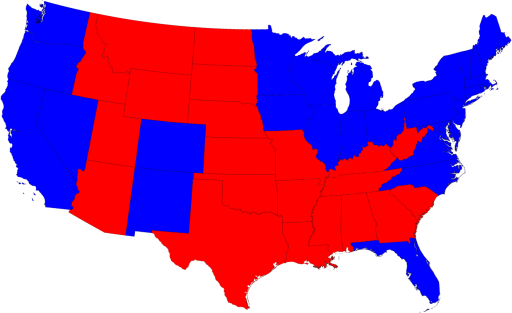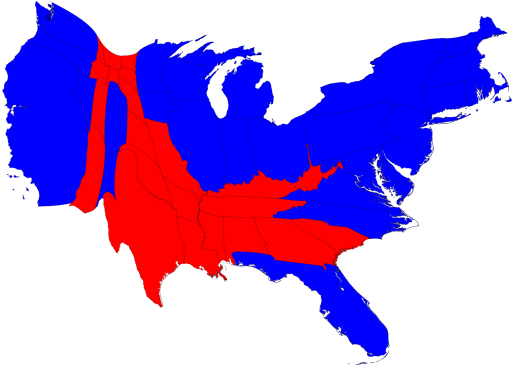Mark Newman, of the Department of Physics and Center for the Study of Complex Systems, at the University of Michigan, shares some interesting views of the recent US presidential election results in Maps of the 2008 US presidential election results.
The states won by Republican candidate John McCain seems to dominate the regular map, even though Democratic candidate and president-elect Barack Obama controlled the Electoral College results.

But the map above is based on area, not on the amount of voters. The Northeast and California have relatively high population densities, while many of the rectangular states in the middle of the country are less densely populated. Mark creates “cartograms” which distort readjust the areas of geographical units to reflect other quantities besides land mass area (“distort” is such an ugly word, normally reserved here for 3D charts).
The cartogram below adjusts the areas of the states so each is proportional to the population of that state. Notice how most of the red states in the middle of the map have shrunk, particuarly in the northern plains. The Northeastern stats and to a lesser extent California have expanded, and the colors on the map match the election results. My boyhood state of Rhode Island is larger than Wyoming (even DC is larger than Wyoming), the Dakotas, and Montana. If Alaska were on this map, it would also be dwarfed by Rhode Island.

Pretty cool. The shapes of the redrawn geographical units are still recognizable, and you come away with a better sense for distribution of votes. On his web site, Mark shows more views of the results of this and previous elections, as well as cartograms based on other measures.



Ran Barton says
These are very intriguing. Flowing Data today discussed another approach that uses varying alpha levels to try to convey the same idea without the geographic distortion.
http://flowingdata.com/2008/11/13/alternative-to-cartograms-using-transparency/
[Greetings from one of your boot camp attendees; what a jampacked and helpful three days that was.]
derek says
The purple maps on the site are disappointing. Purple political maps are fast becoming the second most common example of bad color choice in information graphics (the champion still being the notorious “scientist’s rainbow”). It was a nice pun and a reasonable point to make when Robert Vanderbei of Princeton did it in 2004, but it wasn’t a good presentation of detailed information then, and it still isn’t now.
What’s doubly disappointing is that both Vanderbei and Newman have the same reaction to being corrected: that they’re important busy people who haven’t got time to chane their color scheme for every eccentric who has a different idea. That’s a silly response because they’ve been happy to spend hours making the originals, and it’s a misguided one because the people correcting them aren’t bums off the street, they’re people who know more about this subject than the political scientists do.
Some good articles and papers on this subject are:
http://www.infovis.net/printFicha.php?rec=revista&num=192&lang=2&palabra=color
http://www.research.ibm.com/people/l/lloydt/color/color.HTM
Per these resources, the cure for the poor discrimination of red-purple-blue schems is to abandon the use of pure hue, and instead use a much more limited hue range for labeling only, and use luminance and saturation for continuous discrimination. I made
a red-white-and-blue America map for 2004, they’re no harder than purple maps, and much more rewarding in information. And the symbolism is as good as that of the purple analogy :-)